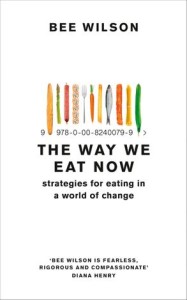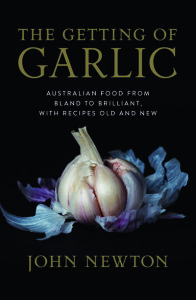“The Way We Eat Now” – Bee Wilson
Wilson wrote this book to point out what is wrong with our food system.
‘It’s now becoming clear that the way most people currently eat is not sustainable – either for the planet or for human health. If we want to stop getting swallowed up by our own food and to re-establish eating as something that gives us both joy and health, it makes sense to find out where we are at right now, how we got here, and what is it that we share.’
This book connects these issues: climate change, shrinking biodiversity, global industrial food complex, large retail marketing, our nutrition, eating habits and changing diet.
Chemicals which are being bombarded on to farms, destroy the necessary insect life. A lot of our foods are over-processed. We often eat it in an anti-social manner, perhaps in front of a screen. Too many of us lack knowledge about food and cooking. A lot of us eat too much, and are attracted by food fads, eg. kale, pomegranates, cauliflower, nut milks, turmeric etc.
Regarding food trends, they sometimes have a dark side eg. Mexican avocadoes are known as ‘blood guacamole’ because the profits have led drug cartels to tax farmers who grow them; those who don’t pay are threatened with violence.
According to Wilson obesity is not totally the fault of our lack of willpower; it’s also the result of a triumph of marketing which most of us are susceptible to eg. sugar-laden breakfast cereals. Large corporates, subsidies, and trade agreements have colluded to create a worldwide food system that concentrates on increasingly large agglomeration of monocultures resulting in narrowing variety and nutrition. Cheap snacks, fizzy drinks, and junk food have penetrated even very traditional cuisines such as in France, India and China.
Eating is not as social as it once was. It’s less likely that we’ll eat at a table of people including family. Some people prefer to watch food shows on TV rather than get off the couch and do it themselves. Delivered food such as from Deliveroo, contributes to this result.
Wilson describes a study of Japanese men who settled in the US. Most assimilated to the western lifestyle resulting in increased heart disease; but not those who stuck to the Japanese traditions and rituals around eating.
Wilson is not judgemental about food or cooking; it appears that she is a reformer. She believes that public policy is the most efficient route to improvement. She explains that Chile and Amsterdam have instituted rules against marketing to children, and strictures to reduce sugar and salt. So it’s not all hopeless !!
 Having attended the Climate Strike at the Domain in Sydney on Friday (20 Sept 2019), I started thinking about whether going vegetarian would help not only the planet, but my health as well. It sounds pretty easy, taking into consideration some nutritional points such as consuming enough proteins and the right vitamins and minerals.
Having attended the Climate Strike at the Domain in Sydney on Friday (20 Sept 2019), I started thinking about whether going vegetarian would help not only the planet, but my health as well. It sounds pretty easy, taking into consideration some nutritional points such as consuming enough proteins and the right vitamins and minerals.